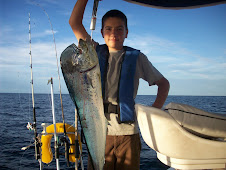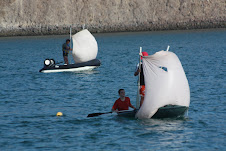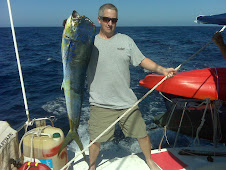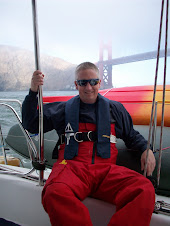As mentioned earlier, we got a HORRIBLE paint job at Abarroa's rail yard in La Paz just a year ago in November 2009. Here are pictures of the deteriorated paint taken a few days ago. Our original bottom paint was that bright marine blue that is so common. That November, we chose to paint the bottom black so that we could keep track of how the paint job was holding up. Within just a few months, the first spots of blue began showing up under the black. (A bottom paint job is "expected" to last about two years in this climate.)
Over the last year, the blue spots just keep getting bigger and spreading over more and more of the boat. The paint job is essentially gone now for all intents and purposes and so the barnacle and seaweed growth is becoming harder and harder to control. We are planning to careen the boat this summer up in the far north of the Sea of Cortez where the tides are more extreme (which will give us more dry time to get the job done over several days) but I wonder if we can keep it going that long. I am a strong believer in the old phrase, "If you want something done right, do it yourself!"
There are lots of stories from cruisers about bottom paint jobs in Mexico. Some have excellent experiences, many don't. We had heard lots of the bad stories and had done everything we could to keep that from happening to us. There are all sorts of tricks to watch for from swapping out a cheaper paint for a more expensive one, to adding paint thinner, or not putting on all the coats of paint they are paid for. One of the best ways to stop this from happening is to monitor the workers constantly. Patrick oversaw the workers, working alongside them, from the paint prep through the painting. When Patrick saw the workers bring out a can of paint thinner, (they like to add it since it makes the paint cover more surface, is easier to work with, but it comprimises the integrity of the paint) he told them not to put it in. They agreed that they would not use it and they set that can aside and did not touch it again. However the next day Patrick found them sneaking paint thinner into the the paint using a different can! We think too much paint thinner is the cause of our problem. The areas that Patrick painted himself with unthinned paint are doing fine. You can see in the pictures the difference. Patrick did the first foot or so of the bows and the three inches around the waterline of the boat.
Not only did Abarroa's do a horrendous job painting, but they also managed to damage our boat with big chunks taken out of our keels, and deep scratches marring both a stainless steel stanchion and a section of fiberglass on the starboard side. It is just too long of a story of ineptitude to repeat here, so I will give the curious a link to our earlier blog post here that documented all of the inept things that happened on that haul out. I know that sometimes you can just get bad service from a good store, but the string of ineptitude along with the horrible outcome is just too much to wish away. If you are thinking of using Abarroa's rail yard in La Paz all I can say is "Buyer beware!"
Below is a close up of Port pontoon - you can follow the tracks of the paint roller the worker was using on the side, and the three inches of paint Patrick painted around the waterline.
There are lots of stories from cruisers about bottom paint jobs in Mexico. Some have excellent experiences, many don't. We had heard lots of the bad stories and had done everything we could to keep that from happening to us. There are all sorts of tricks to watch for from swapping out a cheaper paint for a more expensive one, to adding paint thinner, or not putting on all the coats of paint they are paid for. One of the best ways to stop this from happening is to monitor the workers constantly. Patrick oversaw the workers, working alongside them, from the paint prep through the painting. When Patrick saw the workers bring out a can of paint thinner, (they like to add it since it makes the paint cover more surface, is easier to work with, but it comprimises the integrity of the paint) he told them not to put it in. They agreed that they would not use it and they set that can aside and did not touch it again. However the next day Patrick found them sneaking paint thinner into the the paint using a different can! We think too much paint thinner is the cause of our problem. The areas that Patrick painted himself with unthinned paint are doing fine. You can see in the pictures the difference. Patrick did the first foot or so of the bows and the three inches around the waterline of the boat.
Not only did Abarroa's do a horrendous job painting, but they also managed to damage our boat with big chunks taken out of our keels, and deep scratches marring both a stainless steel stanchion and a section of fiberglass on the starboard side. It is just too long of a story of ineptitude to repeat here, so I will give the curious a link to our earlier blog post here that documented all of the inept things that happened on that haul out. I know that sometimes you can just get bad service from a good store, but the string of ineptitude along with the horrible outcome is just too much to wish away. If you are thinking of using Abarroa's rail yard in La Paz all I can say is "Buyer beware!"
Below is a close up of Port pontoon - you can follow the tracks of the paint roller the worker was using on the side, and the three inches of paint Patrick painted around the waterline.



















Patrick, I don't know if you have picked a paint yet, but I am real happy with the Hempel I bought from the company. It is the same that the Washington State ferries use with a 36 month guarantie? Paid $84 a gallon plus 16% eva and $50 shipping to Obregon. Casey on V'ger
ReplyDeleteCasey,
ReplyDeleteWe already have the Interlux on board for the next paint job, but we will definitely look into it for next time. That sounds like a great deal!
Laura